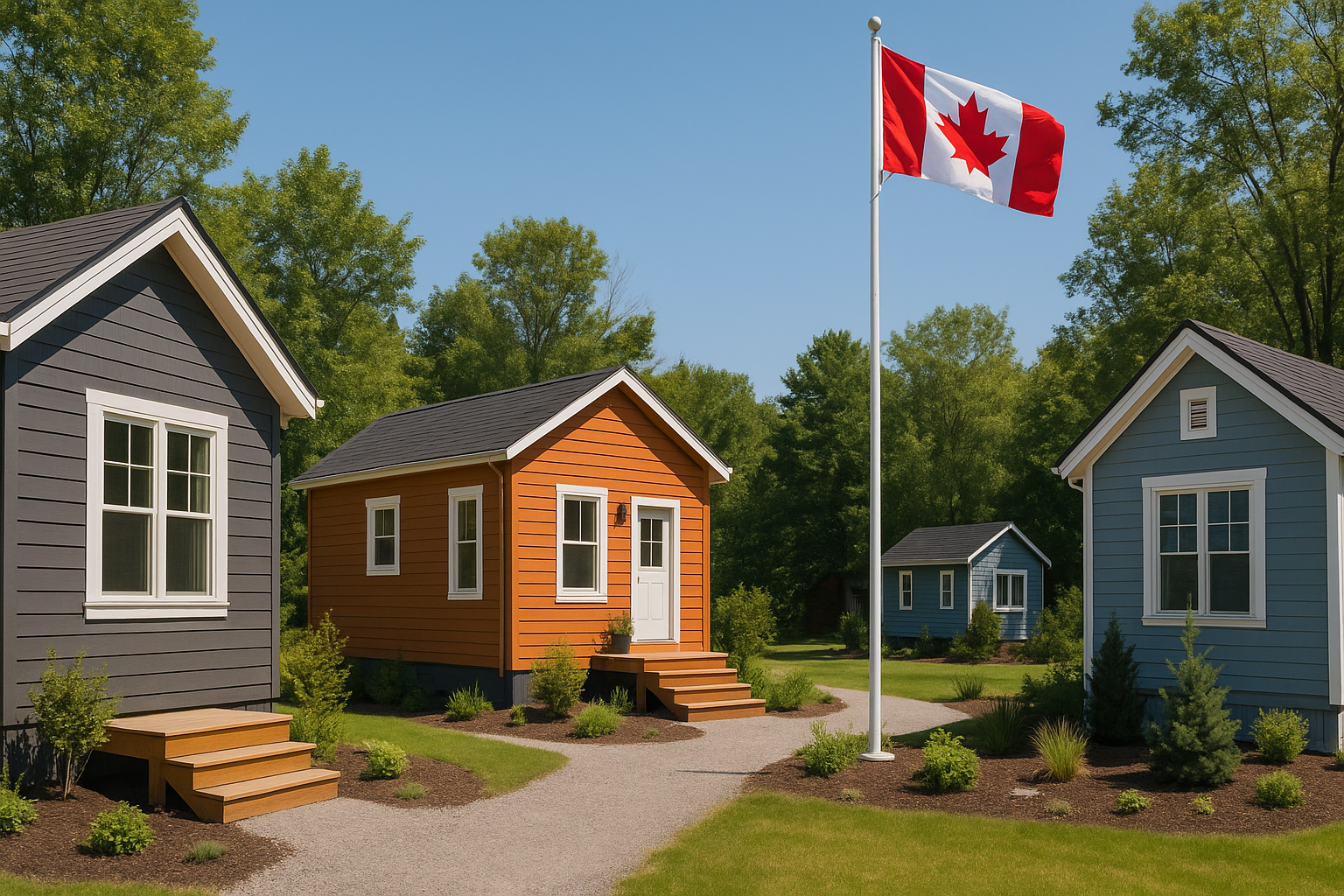
Tiny Homes Multi-Family: A Canadian Guide for Property Owners
Estimated reading time: 8 minutes
Key Takeaways
- Tiny homes multi-family can maximize land use while enhancing privacy in multi-unit developments.
- Accessory Dwelling Units (ADUs) offer flexible rental and ownership models, appealing to diverse demographics.
- Successful integration depends on understanding local zoning regulations and building codes.
- Proper planning, professional consultation, and innovative design are key to a thriving investment.
Table of contents
- Introduction: What Are Tiny Homes Multi-Family?
- Understanding Tiny Homes in Multi-Family Settings
- Canadian Property Investment Opportunities
- Legal Framework and Zoning Regulations
- Practical Landlord Tips for Successful Integration
- Design Approaches for Tiny Homes in Multi-Family Sites
- Case Studies: Tiny Homes Multi-Family Integration
- Conclusion: Next Steps for Canadian Property Owners
- Frequently Asked Questions
Introduction: What Are Tiny Homes Multi-Family?
Tiny homes multi-family refers to the integration of small, self-contained dwelling units—typically sized between 100 to 400 square feet—within larger multi-family properties. These compact living spaces include fully equipped kitchens, bathrooms, and private sleeping areas designed to endure Canadian weather. Unlike micro-suites or shared units, each tiny home is a complete private residence. For more detailed guidelines, check out the Ontario Tiny Home Guide and the insights provided by Squamish Tiny Homes. You can also explore additional perspectives on Tiny Home Living Guide.
Tiny homes are gaining popularity across Canadian cities and suburbs due to rising housing costs, land shortages, and the increasing demand for affordable rental options. They allow property owners to add extra units without sacrificing privacy or functionality.
This guide offers Canadian property owners insights into best practices, legal requirements like zoning regulations, and smart design strategies for incorporating tiny homes or ADUs (Accessory Dwelling Units) into multi-family properties.
Understanding Tiny Homes in Multi-Family Settings
Defining Multi-Family Properties and Integrating ADUs
A multi-family property consists of separate housing units under the same roof or within one building, including duplexes, triplexes, apartment buildings, and townhouse communities.
Tiny homes multi-family integration can occur in two primary ways:
- Standalone Tiny Homes: Self-sufficient units added onto existing properties, often as backyard homes or part of “pocket villages”.
- Integrating ADUs: Secondary suites, such as laneway or garden suites, that are attached to or located near the main building, providing fully independent living spaces.
Accessory Dwelling Units (ADUs) are essential because they enhance property density, support various rental and ownership models, and often utilize existing infrastructure to reduce costs and speed up approval processes.
For additional context, visit the Ontario Tiny Home Guide, or review another resource on Tiny Homes as an Alternative to Conventional Housing. More insights are available from Squamish Tiny Homes and the Accessory Dwelling Units Guide.
Canadian Property Investment Opportunities with Tiny Homes
Maximizing Income and Asset Diversification
Tiny homes present a compelling opportunity for Canadian property investors by:
- Increasing Rental Income: Adding one or more tiny homes can create new revenue streams with competitive rental rates.
- Asset Diversification: Incorporating tiny homes allows investors to reach niche markets—students, young professionals, retirees—and reduce overall risk.
- Reducing Costs, Accelerating Returns: Lower construction and maintenance expenses coupled with shorter build times can lead to faster returns on investment.
- Meeting Market Demand: In high-cost markets like Toronto, Vancouver, Hamilton, and Victoria, there is a significant demand for affordable, flexible living options.
A summary of the investment appeal can be seen in key benefits such as increasing rental income, diversifying assets, reducing costs, aligning with market demand, and benefiting from supportive urban policies. Additional insights can be found on Visions Journal: Rethinking Housing and Canada Tiny House News.
Legal Framework and Zoning Regulations for Tiny Homes
Zoning Regulations: What Landlords Must Know
Zoning regulations are established by local, provincial, or municipal governments and dictate where and how tiny homes and ADUs can be installed. Key aspects include:
- Size Limits: Minimum unit sizes (e.g., Ontario Building Code requires at least 17.5 square metres) and, in some areas, maximum limits to maintain the tiny home scale.
- Permits and Compliance: Approval requires building permits and compliance with National and Provincial Building Codes related to safety, accessibility, and proper servicing.
- Provincial and Municipal Differences: Different jurisdictions vary in their acceptance of tiny homes or ADUs. Cities such as Vancouver, Squamish, and certain Ontario municipalities have proactive policies, whereas others may be more restrictive.
- Common Hurdles: Navigating vague bylaws, restrictive lot coverage, and stringent parking/minimum requirements can be challenging.
Early consultation with local planning departments is crucial to avoid costly mistakes and to explore creative solutions to meet local requirements. For more on this subject, check the Ontario Tiny Home Guide, review details on Squamish Tiny Homes, or read insights from the Canada Tiny House News site.
Practical Landlord Tips for Successful Integration
How Landlords Can Add Tiny Homes or Integrate ADUs
Successful integration of tiny homes requires careful planning and execution. Consider these vital tips:
- Planning & Approvals: Engage early with local planning offices, review zoning bylaws, and work with experienced architects and engineers to secure necessary permits.
- Design & Layout Strategies: Maximize privacy and space with thoughtful placement of doors, windows, and multi-functional furniture. Consider shared amenities like communal laundry or storage areas.
- Tenant Management: Adapt rental agreements to clearly define use of shared versus private areas and establish rules regarding maintenance and communal facilities.
- Maintenance and Financial Planning: Regularly inspect systems unique to tiny homes, plan for preventative maintenance, confirm insurance coverage, and analyze return on investment carefully.
For further reading on optimizing rental profitability and ensuring adequate insurance, explore resources like the Rental Unit Profitability Guide and the ADU Insurance Guide.
Design Approaches for Tiny Homes in Multi-Family Sites
Smart Design Strategies for Space and Sustainability
Effective design is central to the success of tiny homes multi-family integration. Consider these strategies:
- Space Optimization Techniques: Incorporate built-in furniture like Murphy beds, adjustable seating, and vertical storage to make the most of limited space.
- Eco-Friendly Construction: Use high-performance insulation, energy-efficient windows, and sustainable, Canadian-sourced materials to enhance comfort and reduce costs.
- Collaboration with Professionals: Work with designers familiar with compact living solutions and ensure compliance with local building codes and bylaws.
For more ideas on smart design, see resources such as the Tiny Homes Alternative to Conventional Housing document and additional tips on Tiny Home Design in Canada.
Case Studies: Tiny Homes Multi-Family Integration in Canadian Cities
Real-World Successes and Lessons Learned
Across Canada, innovative projects have successfully integrated tiny homes and ADUs:
- Vancouver, BC: Large-scale ADU programs, including laneway housing and pocket villages, have increased rental supply and diversified housing options.
- Squamish, BC: Progressive policies have promoted tiny homes as secondary suites along with shared amenities and communal spaces, leading to thriving high-density communities.
- Ontario Municipalities: Pilot projects in Hamilton and Toronto demonstrate effective blending of ADUs with main properties to boost rental income while fostering community spirit.
These case studies confirm that while challenges like permitting and servicing exist, early planning and clear communication with tenants can lead to successful outcomes. Additional details can be found on the Rethinking Housing page and BC Housing’s publication.
Conclusion: Next Steps for Canadian Property Owners
Tiny homes multi-family solutions are redefining property investment in Canada by increasing rental income, offering asset diversification, and providing sustainable, flexible housing options. However, unlocking these benefits requires an in-depth understanding of zoning regulations, careful planning, and expert consultation.
Canadian property owners should:
- Consult local planning departments to confirm zoning allowances.
- Collaborate with architects and designers experienced in ADU and tiny home projects.
- Review local bylaws, financing options, and insurance policies before proceeding.
Call to Action: If you’re ready to transform your multi-family property into a more versatile, income-generating asset, begin by exploring your city’s official tiny home and ADU guidelines and seek professional advice for a smooth transition.
For further reading, consider these resources:
Frequently Asked Questions
Q1: What qualifies a unit as a tiny home in a multi-family setting?
A: Tiny homes typically range from 100 to 400 square feet and include complete living facilities. They can be standalone structures or integrated as ADUs attached to existing properties.
Q2: Are there specific zoning regulations for tiny homes in Canada?
A: Yes, zoning regulations vary by municipality and province. It’s essential to consult local planning authorities to understand size limits, permit requirements, and other building code specifications.
Q3: How can integrating ADUs benefit property investment?
A: ADUs can provide additional rental income, diversify your portfolio, and offer flexible housing options that appeal to various tenant demographics—all while often utilizing existing infrastructure to reduce costs.

Leave a Reply